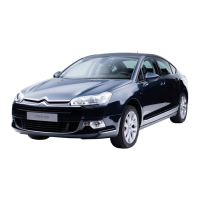U
The Citroën Guide Suspension: Hydractive II 30
lets the pressure inside the center sphere 1 move the con
-
trol piston into a position which closes off the center sphere
completely.
The center sphere 1 is now supplied directly from the
height corrector in soft mode. This simplifies the ball valve
arrangement with respect to Hydractive I.
Higher intelligence
The computer uses the same set of sensors as Hydractive I,
the only difference is the vehicle speed sensor which is a
Hall-effect sensor now. Its resolution have been doubled to
8 pulses generated per rotation, that is approximately 5
pulses per meter traveled (although this depends some
-
what on tire size). It is located on the gearbox where the
speedometer cable attaches, or in some versions, on the ca
-
ble itself.
The internal algorithm of the computer became more so
-
phisticated. While the Hydractive I had only one computer
controlled mode (Sport switched the suspension to con
-
stant hard mode above 30 km/h of vehicle speed), the
newer system has two such regimes of operation: in both
Normal and Sport it dynamically activates the electro-valves
of the suspension control blocks whenever it decides that
the driving circumstances call for a firmer suspension. The
difference is in the set of rules the computer uses to evalu
-
ate those circumstances: the rules are stricter for the Sport
setting, with most of the thresholds reduced, thus the sus
-
pension will switch to hard mode much more readily.
The following table shows the thresholds of steering
wheel angle. If the value observed by the sensor exceeds
the threshold for the actual vehicle speed and the suspen
-
sion setting, the suspension will switch to hard mode; it will
revert to soft when the corresponding value drops below
the threshold for at least 1.5 seconds:
Vehicle
speed
(km/h)
Steering wheel
angle (deg)
Vehicle
speed
(km/h)
Steering wheel
angle (deg)
Normal Sport Normal Sport
< 34 — — 90–99 33 22
34–39 174 119 100–119 26 27
40–49 100 67 120–139 23 15
50–59 84 56 140–158 20 13
60–68
68 45 159–179 13 9
69–78 55 37 179 > 10 7
79–89 42 28
There is a similar table for the thresholds of the steering
wheel rotational speed as well:
Vehicle
speed
(km/h)
Steering wheel
speed (deg/s)
Vehicle
speed
(km/h)
Steering wheel
speed (deg/s)
Normal Sport Normal Sport
< 24 — — 79–89 62 41
24–29 535 357 90–99 53 35
30–39 401 267 100–119 42 28
40–49 246 164 120–139 30 20
50–59 178 119 140–158 22 15
60–68 110 73 158 > 20 13
69–78 82 55
The thresholds for body movement are:
Vehicle
speed
(km/h)
Dive
(mm)
Squat
(mm)
Steering
wh pos
(deg)
Vehicle
speed
(km/h)
Dive
(mm)
Squat
(mm)
Steering
wh pos
(deg)
< 10 — — — 100–109 48 48 13
10–33 84 60 — 110–119 48 42 13
34–39 84 60 87 120–129 48 42 11.5
40–49 54 48 50 130–139 42 42 11.5
50–59 54 48 42 140–149 42 42 10
60–68 54 48 34 150–158 42 36 10
69–78 54 48 27.5 159–179 42 36 6.5
79–89 54 48 21 179 > 36 36 5
90–99 48 48 16.5
Note that the thresholds are the same for both Normal and Sport suspension settings
The thresholds of the gas pedal sensor are:

